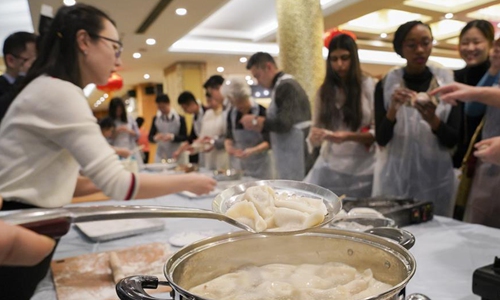Dumplings for reunions and good wishes

Students make dumplings during a New Year gala for Chinese and international youth in New York, the United States, Jan. 19, 2020. The great hall of the Chinese Consulate General in New York was filled with joyful laughter, beautiful melodies and the smell of dumplings on Sunday night. Some 200 Chinese, U.S. and other international college students gathered here for a Lunar New Year Gala to welcome the Year of the Rat. Photo:Xinhua
On the Chinese New Year's Eve, anonymous strangers sent dumplings to hospitals in Wuhan, Hubei Province, as medical staff couldn't be with their families as they were busy on the frontlines fighting against the novel coronavirus. In the face of adversity, enjoying the simple things of life such as a meal of hot and delicious dumplings can be a soulful moment.
To some extent, dumplings can be considered a cultural symbol in China. Homemade dumplings are often associated with homesickness, as flavors and ingredients vary from family to family and are distinguished by region.
Dish for family reunion
Dumplings are a long-standing festival regular. Traditionally, people eat dumplings on the first day, the fifth day and the 15th day of the Chinese New Year, as well as the first day of Sanfu (the hottest days of summer) and the Winter Solstice. It is an embodiment of festivals and gatherings, representing Chinese people's best hopes and wishes about families.
Dumplings are known as jiaozi in Chinese. There is a saying "Chi jiaozi, jiao haoyun," meaning eating dumplings gives you good luck. On Chinese New Year's Eve, people eat jiaozi at midnight, kicking off the new year with good luck. Therefore, such an auspicious dish must require the full engagement of the entire family.
Families gather around the table, each performing their duties in a highly coordinated and harmonious system - making the filling, the dough, the skin, wrapping the fillings in the skins and then boiling the dumplings. As for the children, they'd be usually assigned to arrange the dumplings evenly as they wait to be boiled.
Variations across the country
People in Beijing like to pair their dumplings with laba garlic, a type of vinegar-preserved garlic. In Tianjin, there is a custom to eat vegetarian dumplings on the first day of the Chinese New Year.
In some parts of China, people like their dumplings in broth or soup. Take East China's Jiangxi Province for example. The dumplings there are often accompanied by chicken broth, seaweed, shrimps and a dash of spring onions. Likewise, Northwest China's Shaanxi Province is known for its dumplings in hot and sour soup. Vinegar, homemade chili oil, cilantro, sesame are added to the soup to really bring out the flavor of the dumplings.
Meanwhile, people in South China's Guangdong Province have shrimp dumplings. The fillings are made of bamboo shoots, pork and shrimps. There is also yupi jiao, the skins of which are skillfully made from fish skin. While the fillings can be seen through the translucent skins, the dumplings won't become misshaped or break in the boiling water.
The list goes on for the extensive variations of dumplings across the country. Hopefully, the battle against coronavirus will soon to be ended, and each family can gather around the table and savor the unique flavors and memorable moment.